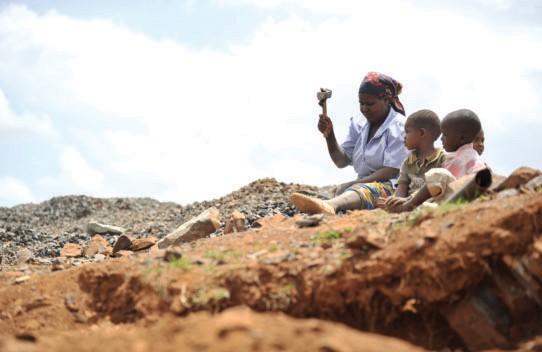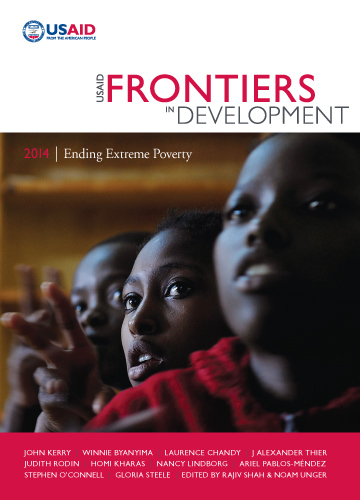Catherine Cozzarelli and Susan Markham
At the heart of USAID’s new mission statement is a commitment to working with partners around the globe to end extreme poverty. This priority, which we share with other development practitioners, is central to the goals of the post-2015 Development Agenda. Demonstrating progress toward this target requires the assessment and tracking of extreme poverty levels.
Measuring Poverty
Traditionally, poverty and extreme poverty have been assessed at the household level via income- or consumption-based measures, most frequently in relation to the purchasing-power-parity-based World Bank guidelines currently estimated at $2 for poverty and $1.25 for extreme poverty. However, feminists and other researchers applying a gender lens to the study of extreme poverty have long argued that these gender-blind measures do not accurately capture the prevalence of extreme poverty among females as compared to males; nor do they capture the complexities and differences in how women and men experience poverty.1
To accurately compare the prevalence of extreme poverty among women as compared to men, researchers must assess poverty at the individual, rather than household, level. This has proven to be a steep methodological challenge. Household-level assessments are based on the assumption that all household income or assets are shared equally among household members.
Yet a wealth of research now shows that women are often severely disadvantaged within their households, challenging the assumption that they benefit from an equal share of resources or control over income or assets. Therefore, to assess poverty at the individual level, researchers must estimate within-household inequalities. Modeling, at best an imprecise endeavor, is often used to do so.
Aside from the methodological challenges, the conceptual question exists of whether poverty should be assessed using only income-based measures. Many experts have argued that, just as human well-being is a multidimensional concept, poverty measures should likewise reflect the numerous forms of deprivation that men and women often experience.

Women’s experiences of extreme poverty can be more complex and multifaceted than men’s. In many cases, they are starting from more marginalized, less powerful positions than men, and any additional burdens will further exacerbate these differences. 2 In addition, the multiple ways that social norms and expectations impact the lives of women and men ensure that the experience of extreme poverty will be profoundly impacted by gender.
Women’s experiences of poverty
Income is but one important dimension of how women experience poverty. Although no universally accepted set of key dimensions yet exists, deprivations in knowledge, nutrition and health, property ownership, time and decision-making power are among the most frequently mentioned. 3 Consider, for example, Amartya Sen’s very influential framing of poverty beyond the lack of economic resources to include deficits in capacities and opportunities to “lead the kind of lives that people have reason to value.”4 According to this formulation, economic resources are just one of many resource types needed to experience a life that has value and dignity.
Abundant research makes it clear that women in many parts of the world have lower levels of education and less access to resources, capabilities and opportunities than men.5 In this sense, they can certainly be considered to be poorer. Take for example the persistent gender gap in employment. In 2012, there was a 24.8 percentage point difference in the employment-to-population ratio for women as compared with men.6 Women are more likely than men to be employed in the informal sector, are typically stratified into jobs that pay lower wages and have less access to productive assets and financial resources.7
Across 63 developing countries, girls in both primary and lower secondary age groups were more likely to be out of school than boys. This school attendance gender gap widens in lower secondary education, even for girls living in better-off households.8
Furthermore, although the unmet need for family planning declined in all regions between 1990 and 2013, an estimated 140 million women who wanted to stop or delay childbearing did not have access to family planning in 2013.9 In many countries, women have less influence over household decisions than men, and they are much less likely than men to hold positions of political power.10 Finally, in most countries, gender inequalities tend to be greater among the poor than the rich, especially inequalities related to education, health and economic opportunity.11
It is also important to consider differences in how women and men cope with extreme poverty and how these responses can deepen many dimensions of poverty itself. When household economic resources are constrained, for example, women may respond by increasing the time they spend earning income, in addition to maintaining routine care work in the home. Because men, regardless of whether they are earning an income, often do not increase the amount of time they spend on housework or care responsibilities, this often means that women work far longer hours, have less leisure time and suffer from higher levels of time poverty.12
Men more often than women cope with poverty by seeking escapes, through the use of alcohol or drugs or by abandoning their families and the attendant financial obligations. Such strategies deplete household resources and put the onus on women and older girls to shoulder additional responsibilities and find ways to cope.13
Moving forward
Moving forward in the battle against extreme poverty, USAID and its partners should measure progress not just in terms of the ability of women and girls to earn and make use of income, but also in terms of their empowerment. This can be gauged in terms of decision-making power in households and communities, increased skills and capacities, the ability to benefit equally from assets and resources and progress in building more equitable relationships with their male partners. By viewing women’s multidimensional and complex experiences of poverty in this way, we will bring our work in line with current research and help it more effectively respond to the experiences of women living in extreme poverty.
Many ongoing USAID programs clearly contribute to reaching these gender equality objectives. The Agency has helped develop women’s capacities as political and social leaders, increased their access to key agricultural resources and quality health and nutrition services, supported female entrepreneurs and equipped young women with the education and technical skills they need to earn a decent living.
But we could do more. This includes collecting data at the individual level that will tell a deeper and richer story about how women worldwide experience extreme poverty. Information on key dimensions such as access to or control over assets, participation in informal employment and unpaid work and use of time are not routinely collected in most countries. It will be important to build upon efforts to systematically collect these data as the international community works toward key gender goals and targets in the context of the post-2015 Development Agenda.
Programmatic responses to extreme poverty must recognize the intersections of gender roles and norms, of social structures and stratifications and of state programs and policies as determinants of outcomes for individual women and men. We must design programs tailored to the specific, gender-based challenges faced by the women we are seeking to empower.14
Catherine Cozzarelli is the senior gender adviser in the USAID Bureau for Policy, Planning and Learning, and Susan A. Markham is the USAID senior coordinator for gender equality and women’s empowerment.
The views expressed in this essay are their own and do not necessarily represent the views of the United States Agency for International Development or the United States Government.
1 Chant, S. (Ed.) (2010). International Handbook of Gender and Poverty: Concepts, Research, Policy. Cheltenham: Edward Elgar.
2 Coates, A. (2010). “Multidimensional poverty measurement in Mexico and Central America: Incorporating rights and equality,” In Chant, S. (Ed.) (2010). The International Handbook of Gender and Poverty: Concepts, Research, Policy. Cheltenham: Edward Elgar.
3 Chant, S. (2008). “The ‘Feminisation of Poverty’ and the ‘Feminisation’ of Anti-Poverty Programmes: Room for Revision?” Journal of Development Studies, Vol. 44, No. 2, pp. 165–197, February.
4 Sen, A. (1999). Development as Freedom. New York: Anchor Books.
5 World Bank. (2011). World Development Report 2012: Gender Equality and Development. Washington D.C.: The World Bank.
6 http://www.unwomen.org/en/news/in-focus/mdgmomentum# MDG1
7 Grown, C. (2014). “Missing women: Gender and the extreme poverty debate.” A paper prepared for USAID under Award #AIDOAA- 0-13-00103 Mod 1.
8 http://www.unwomen.org/en/news/in-focus/mdgmomentum# MDG2
9 http://www.unwomen.org/en/news/in-focus/mdgmomentum# MDG5
10 World Bank. (2011). World Development Report 2012: Gender Equality and Development. Washington D.C.: The World Bank.
11 World Bank. (2011). World Development Report 2012: Gender Equality and Development. Washington D.C.: The World Bank. Also, Duflo, E. (2011). “Women’s empowerment and economic development”: National Bureau of Economic Research.
12 Chant, S. (2010). “Towards a (re)conceptualization of the ‘feminization of poverty’: Reflections on gender-differentiated poverty from The Gambia, Philippines and Costa Rica.” In Chant, S. (Ed.) (2010). The International Handbook of Gender and Poverty: Concepts, Research, Policy. Cheltenham: Edward Elgar.
13 Chant, S. (2007). Gender, Generation and Poverty: Exploring the “Feminization of Poverty” in Africa, Asia and Latin America. Cheltenham, UK and Northampton, MA, USA: Edward Elgar.
14 For an excellent discussion of the types of programmatic responses most likely to benefit poor and very poor women, see Grown, C. (2014). “Missing women: Gender and the extreme poverty debate.” A paper prepared for USAID under Award #AID-OAA-0-13-00103 Mod 1.
Frontiers in Development
Section 1: Understanding Extreme Poverty








Comment
Make a general inquiry or suggest an improvement.